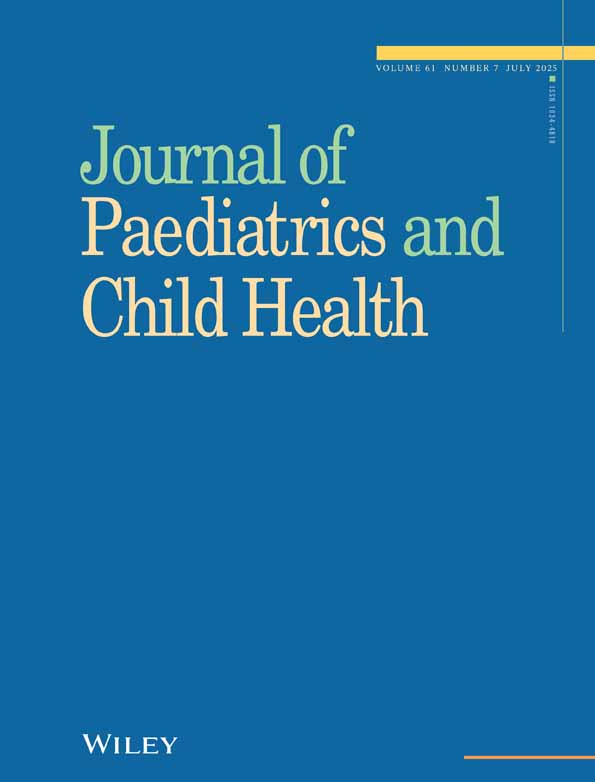Aganglionosis: Associated anomalies
Corresponding Author
D. CASS
Paediatric Surgical Unit, Department of Paediatrics, Westmead Hospital, NSW, Australia
Paediatric Department, Westmead Hospital, Westmead, NSW 2145, Australia.Search for more papers by this authorCorresponding Author
D. CASS
Paediatric Surgical Unit, Department of Paediatrics, Westmead Hospital, NSW, Australia
Paediatric Department, Westmead Hospital, Westmead, NSW 2145, Australia.Search for more papers by this authorD. Cass, FRACS, Paediatric Surgeon.
Abstract
Abstract In a series of 21 patients with aganglionosis there were five with associated anomalies (24%). These included trisomy 21, Smith-Lemli-Opitz syndrome type II, persistent Müllerian duct syndrome, supernumerary digits and segmental hypopigmentation. This high incidence may be due to sample bias, but clinicians are encouraged to carefully follow their aganglionic patients as there may be under-reporting of associated anomalies. Knowledge of these anomalies can help in the management of individual patients and subsequent pregnancies. In addition these diverse associated anomalies suggest that as well as sometimes being part of a vagal neural crest deficiency, aganglionosis can be part of a generalized mesenchymal defect in embryonic development. There are probably several genes involved.
References
- 1 Cass D. T. Hirschsprung's disease: a historical review. Prog. Pediatr. Surg. 1986; 20 199–214.
- 2 Bodian M., Carter C. O. A family study of Hirschsprung's disease. Ann. Hum. Genet. 1963; 26: 261–77.
- 3 Passage E. The genetics of Hirschsprung's disease—Evidence for heterogeneous etiology and a study of sixty-three families. N. Engl. J. Med. 1967; 276: 138–43.
- 4 Passage E. Genetic heterogeneity and recurrence risk of congenital intestinal aganglionosis. Birth Defects 1972; 8: 63–7.
- 5 Swenson O., Sherman, J. O., Fisher, J. H. Diagnosis of congenital megacolon: an analysis of 501 patients. 1973; J. Pediatr. Surg. 8: 587–94.
- 6 Iked K., Goto S. Diagnosis and treatment of Hirschsprung's disease in Japan: An analysis of 1628 patients. Ann. Surg. 1984; 199: 400–5.
- 7 Cohen I. T., Gadd M. A. Hirschsprung's disease in a kindred: A possible clue to the genetics of the disease. J. Pediatr. Surg. 1982; 17: 632–5.
- 8 Branski D. Hirschsprung's disease and Waardenburg's syndrome. Pediatrics 1979; 63: 803–5.
- 9 Kaplan P., De Chaderevian J-P. Piebaldism-Waardenburg syndrome: Histopathologic evidence for a neural crest syndrome. Amer. J. Med. Genet. 1988; 31: 679–88.
- 10 Shah K. N., Dalal S. J., Desai M. P., Sheth P. N., Joshi N. C., Ambani L. M. White forelock, pigmentary disorder of irides, and long segment Hirschsprung's disease: Possible variant of Waardenburg syndrome. J. Pediatr. 1981; 99: 432–5.
- 11 Currie A. B. M., Haddad M., Honeyman M., Boddy S-A. M. Associated developmental abnormalities of the anterior end of the neural crest: Hirschsprung's disease—Waardenburg's syndrome. J. Pediatr. Surg. 1986; 21: 248–50.
- 12 McKusick V. A. Congenital deafness and Hirschsprung's disease. N. Engl. J. Med 1973; 296: 691.
- 13 Santos H., Mateus J., Leal M. J. Hirschsprung disease associated with polydactyly, unilateral renal agenesis, hypertelorism, and congenital deafness: a new autosomal recessive syndrome. J. Med. Genet. 1988; 25: 204–8.
- 14 Curry C. J. R., Carey J. C., Holland J. S. et al. Smith-Lemli-Opitz syndrome-type II: Multiple congenital anomalies with male pseudo-hermaphroditism and frequent early lethality. Amer. J. Med. Genet. 1987; 26: 45–57.
- 15 Lowry R B., Miller J. R., MacLean J. R., Micrognathia, polydactyly and cleft palate. J. Pediatr. 1968; 72: 859–61.
- 16
Kim E. H.,
Boutwell W. C.
Smith-Lemli-Opitz syndrome associated with Hirschsprung's disease, 46, XY female karyotype, and total anomalous pulmonary venous drainage.
J. Pediatr.
1985; 106: 661.
10.1016/S0022-3476(85)80382-6 Google Scholar
- 17 Lipson A., Hayes A. Smith-Lemli-Opitz syndrome and Hirschsprung disease. J. Pediatr. 1984; 105: 177.
- 18 Patterson K., Toomey K. E., Chandra R. S. Hirschsprung disease in a 46, XY phenotypic infant girl with Smith-Lemli-Opitz syndrome. J. Pediatr. 1983; 103: 425–7.
- 19 Le Merrer M., Briard M. L., Girard S., Mulliez N., Moraine C., Imbert M. C. Lethal acrodysgenital dwarfism: a severe lethal condition resembling Smith-Lemli-Opitz syndrome. J. Med. Genet. 1988; 25: 88–95.
- 20 Reynolds J. F., Barber J. C., Alford B. A., Chandler J. G., Kelly T. E. Familial Hirschsprung's disease and type D brachydactyly: a report of four affected males in two generations. Pediatrics 1983; 71: 246–9.
- 21 Lamont M. A., Fitchett M., Dennis N. R. Interstitial deletion of distal 13q associated with Hirschsprung's disease. J. Med. Genet. 1989; 26: 100–4.
- 22 Webb G. C., Keith C. G., Campbell N. T. Concurrent de novo interstitial deletion of band 2p22 and reciprocal translocation (3;7) (p21;q22). J. Med. Genet. 1988; 25: 125–7.
- 23
Cass D. T.,
Myers N.
Total colonic aganglionosis. 30 years' experience.
Pediatr. Surg. Int.
1987; 2: 68–75.
10.1007/BF00174176 Google Scholar
- 24 MacKinnon A. E., Cohen S. J. Total intestinal aganglionosis an autosomal recessive condition? Arch. Dis. Child. 1977; 52: 898–9.
- 25 McCredie J. Embryonic neuropathy: a hypothesis of neural crest injury as the pathogenesis of congenital malformations. Med. J. Aust. 1974; 1: 159–63.
- 26 LeDourin N. M. The Neural Crest. Cambridge University Press, Cambridge . 1982.
- 27 Kirby M. L., Bockman D. E. Neural crest and normal development: A new perspective. Anal. Rec. 1984; 209: 1–6.
- 28 Lewis J., Martin P. Limbs: a pattern emerges. Nature 1989; 342: 734–5.
- 29 Donahue P., Cate R. L., MacLaughlin D. T. et al. Müllerian inhibiting substance: gene structure and mechanism of action of a fetal regressor. Rec. Prog. Horm. Res. 1987; 43: 431–67.
- 30 Wolgemuth D. J., Behringer R. R., Mostoller M. P., Brinster R. L., Palmiter R. D. Transgenic mice overexpressing the mouse homoeobox-containing gene Hox-1.4 exhibit abnormal gut development Nature 1989; 337: 464–7.
- 31 Badner J. A., Chakravarti A. Waardenbury syndrome and Hirschsprung's disease: evidence for pleiotrophic effects of a single dominat gene. Amer. J. Med. Genet. 1990; 35: 100–4.




